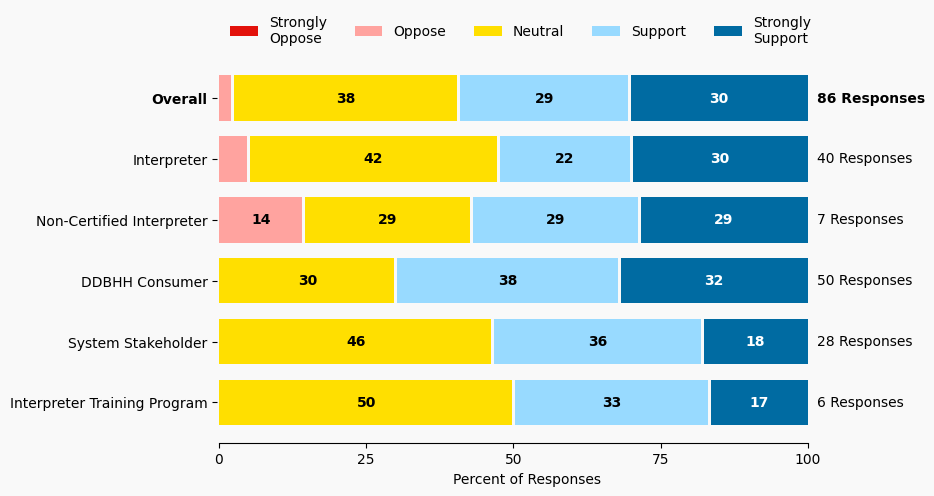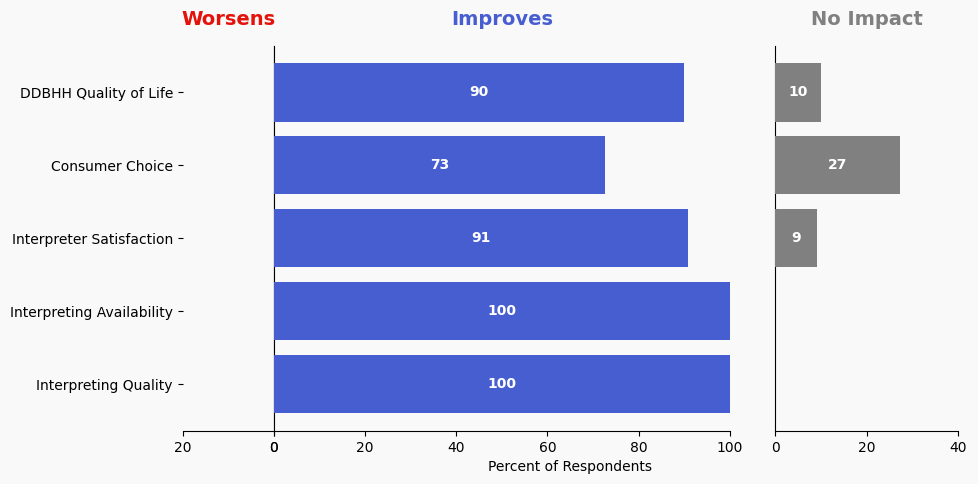93 Return to RSA Model for Recruiting HS Students to ITPs
Issue: Interpreter shortage
Proposed Solution: Coalition create a funded program of ambassadors to visit high schools and colleges to recruit students for college and university interpreting programs. Research would need to be conducted to find, update and/or create recruiting materials.
Expected outcome: Greater availability of interpreting services. As the high school to proficient interpreter timeframe is 5-10 years, the positive impacts of this initiative would be realized in the Long-term.
Who is impacted: ASL students, interpreter training programs
Timeline: 6 months
Note: RSA is the Rehabilitation Services Administration, which previously had an Interpreting Ambassadors program recruiting high school students to become interpreters.

Summary of Support Image Description
The stacked bar charts show how respondents rated their level of support and the total number of responses. The percentage for the five support levels is shown from left to right: Strongly Oppose (Dark Red), Oppose (Light Red), Neutral (Yellow), Support (Light Blue), and Strongly Support (Dark Blue).
Respondents may identify with multiple subgroups. The overall level of support is:
Overall
Strongly Oppose: 0%
Oppose: 2%
Neutral: 38%
Support: 28%
Strongly Support: 30%
Click to see the detailed image description for each subgroup.
Interpreter
Strongly Oppose: 0%
Oppose: 5%
Neutral: 42%
Support: 22%
Strongly Support: 30%
Non-Certified Interpreter
Strongly Oppose: 0%
Oppose: 14%
Neutral: 28%
Support: 28%
Strongly Support: 28%
DDBHH Consumer
Strongly Oppose: 0%
Oppose: 0%
Neutral: 30%
Support: 38%
Strongly Support: 32%
Interpreter Training Program
Strongly Oppose: 0%
Oppose: 0%
Neutral: 50%
Support: 33%
Strongly Support: 17%
System Stakeholder
Strongly Oppose: 0%
Oppose: 0%
Neutral: 46%
Support: 36%
Strongly Support: 18%
Overview of Respondents Opting for In-Depth Solution Analysis
After indicating their support level, 6% of the 86 respondents opted in to further assess whether the solution would worsen or improve on five metrics. Of the opt-in reviewers (6 respondents), 50% supported the solution, 16% were neutral on the solution, and 33% opposed the solution.
The remaining 80 respondents did not opt in to further assess the solution. Of these people, 60% support the solution, 40% were neutral on the solution, and 0% opposed the solution.
Reviewer Evaluation of Solution Effectiveness

Solution Effectiveness Image Description
The stacked bar charts show how respondents assessed the effectiveness of this solution based on five metrics. For each metric, the percentage of respondents is shown from left to right: Worsens (Red), Improves (Blue), No Impact (Gray).
DDBHH Quality of Life
Makes It Worse 0%
Makes It Better 90%
No Impact 10%
Interpreter Satisfaction
Makes It Worse 0%
Makes It Better 90%
No Impact 9%
Consumer Choice
Makes It Worse 0%
Makes It Better 72%
No Impact 27%
Interpreting Availability
Makes It Worse 0%
Makes It Better 100%
No Impact 0%
Interpreting Quality
Makes It Worse 0%
Makes It Better 100%
No Impact 0%
Reviewer Feedback and Insights
Interpreter
Comments from Interpreters support speaking with younger students to encourage them to take ASL classes and explore options like independent study. Another comment expresses interest in a dedicated recruitment program for interpreters and suggests involving Deaf interpreters as ambassadors. One comment supports recruitment efforts from a group separate from ITPs and involving current interpreting students in the recruitment process to improve effectiveness.
Deaf, DeafBlind, Hard of Hearing
Comments from DDBHH Consumers emphasize the need for investment in high school ASL programs, including additional funding, teacher training, scholarships, and collaboration with ITPs and interpreter agencies to build interest in ASL.
System Stakeholder
Comments from System stakeholders suggest involving current students in recruitment and support separating recruitment efforts from ITPs for greater impact.
PREVIOUS SOLUTION
92 Recruit ITP Students from Career Fairs
Issue: Interpreter shortage
NEXT SOLUTION
94 Establish ASL Summer Camp as Feeder to Interpreter Training Programs (ITPs)
Issue: While Camp ASL and high school ASL classes are strong supports for ASL fluency, having additional options as entry points for people to become ASL fluent are still lacking.
Leave a Reply